When I last wrote about my great-grandfather Isidore Schoenthal, he and my great-grandmother Hilda (Katzenstein) and their four children, Lester, Gerson, Harold, and my grandmother Eva had moved from Washington, Pennsylvania, to Denver, Colorado, around 1907, when my grandmother was just three, and her brothers were nineteen (Lester), fifteen (Gerson), and six (Harold). They moved out west because Gerson had severe allergies and asthma and the doctors had recommended a drier climate than western Pennsylvania. My great-grandfather, who had been a glass and china merchant in Pennsylvania, became a salesman and then a store manager for the Carson Crockery Company out in Denver.
I wasn’t sure what kind of Jewish community existed in Denver in the early 20th century, but I learned from a newspaper search that my great-grandparents had joined a synagogue, Temple Emanuel, when they relocated, as evidenced first by this article listing my great-uncle Gerson as a member of the 1908 confirmation class:
Temple Emanuel in Denver has in fact a long and distinguished history, as described in their website:
Temple Emanuel is the oldest Jewish congregation in the state of Colorado, founded in 1874. It is the largest Jewish congregation between Kansas City and the West Coast. It had its early beginnings in a burial and prayer society that was organized in 1866. By 1874, two years before Colorado became a state, the congregation was officially incorporated by 22 members. Within the first year membership was almost doubled and on September 28, 1875, its first synagogue was dedicated. This was located at what is now the corner of 19th and Curtis streets. Early in 1876, the congregation engaged its first full-time rabbi.
The congregation grew and prospered with the community. It soon outgrew its original home. By 1882 a new synagogue was erected at 24th and Curtis Streets. Even though this structure was gutted by fire in 1897, the building still stands today. After the fire, the congregation decided to build at another location because many of its members no longer lived near Temple. The location at 16th Avenue and Pearl streets was chosen. In January of 1899, our third home was dedicated. In 1924 this building was doubled in size.
![By Jeffrey Beall (Own work) [CC BY-SA 3.0 (http://creativecommons.org/licenses/by-sa/3.0)], via Wikimedia Commons](https://brotmanblog.com/wp-content/uploads/2015/12/1024px-temple_emanuel_pearl.jpg?w=584&h=352)
Temple Emanuel on Pearl Street, Denver. By Jeffrey Beall (Own work) [CC BY-SA 3.0 (http://creativecommons.org/licenses/by-sa/3.0)%5D, via Wikimedia Commons
Denver thus had a thriving Jewish community by the time my great-grandparents arrived in the early 20th century. According to several sources, one reason for the surge in the Jewish population of Denver was that it had become a popular location for tuberculosis treatment. Just as my family moved there because of Gerson’s asthma, many others were attracted to the dry climate as a possible cure for tuberculosis. (Some may recall the story of my cousin Ben Brotman who went to Denver for treatment and ultimately died there.)
Many Orthodox Jews settled in Denver seeking a cure for tuberculosis, the “white plague.” Two Jewish institutions were founded to respond to their needs and other sufferers of consumption from around the country. The National Jewish Hospital for Consumptives was opened in 1899. Its name was changed in 1985 to the National Jewish Center for Immunology and Respiratory Medicine. It is now the National Jewish Medical and Research Center, with a worldwide reputation in the research and treatment of allergy and pulmonary diseases. The Jewish Consumptives Relief Society was established just outside of Denver in 1904 to serve the religious needs of suffering Orthodox Jews.

The B’nai B’rith Building at National Jewish Hospital in Denver, Colorado. (Photo credit: Wikipedia)
One of the most well-known Jewish residents of Denver was Golda Meir:
The Golda Meir House Museum is where the future Israeli Prime Minister (1898-1978) lived with her sister and brother-in-law Shayna and Sam Korngold and niece Judith during 1913 and 1914, after she ran away from parents’ home in Milwaukee—she learned that they had a husband picked out for her…and that married women were not allowed to teach there. In her 1975 autobiography, My Life, she states, “It was in Denver that my real education began…” The Korngold house was considered a social and intellectual haven by numerous Jewish immigrants from Russia (Golda’s family had left Kiev in 1906), most of whom had traveled out west for medical treatment. In this environment, Goldie discussed politics, met her future husband Morris Meyerson and developed her future political philosophy. She became deeply involved with Zionism and made the decision to emigrate to what was then Palestine.

English: , Israeli PM. עברית: ראש הממשלה הרביעית של ישראל. Português: , Primeira Ministra Israelense Türkçe: İsrail’in dördüncü başbakanı Golda Meir. (Photo credit: Wikipedia)
Golda was only a teenager when she moved to Denver, not much younger than my great-uncle Gerson and only three years older than my great-uncle Harold. I wonder if she or the Korngolds ever crossed paths with my relatives.
In 1910, my great-grandfather continued to work as the manager of the crockery store. Lester, now 22, was in the US Navy, working at a hospital, and Gerson, 18, was working as a clerk in an office, according to the census record. Both were still living at home with their parents.
My grandmother and her brother Harold made the local newspaper in 1910; they are the adorable little girl and boy in Picture #3 below:
In 1915, when he was fourteen, my great-uncle Harold was busy with the Boy Scouts:
Boy Scouts continued to be a big part of his life, as I found several news articles listing him as a member of the Scouts.
Meanwhile, in December 1915, his sister, my grandmother Eva, then eleven years old, played the Old Woman Who Lived in a Shoe in the Temple Emanuel Hanukkah play. She is the girl in the bonnet on the far left, top row:
While Harold and Eva were still growing up, the other family members were busy working. My great-grandfather Isidore and his middle son Gerson were employed in various ways during the 1910s, while Lester spent much of those years in the Navy. In 1913 Gerson was a clerk for the Sam Lang Importing Company, and my great-grandfather Isidore now seemed to be in the insurance business. (Interestingly, his brother Henry, who had also been a merchant for many years, had also turned to the insurance business after 1910.) The following year, 1914, Isidore was a bookkeeper for Court Place Liquor Company. But in 1915, Isidore is listed once again working for the Carson Crockery Company as a foreman, and Gerson was a salesman for the Sam Lang Importing Company. Even Harold, now fifteen, had a separate listing in the 1916 Denver directory, but without an occupation listed as he was still in school.
Harold was confirmed at Temple Emanuel in the spring of 1916; he was fifteen.
On June 30, 1917, Lester Schoenthal married Juliet Grace Beck, sometimes referred to in later documents as Grace and sometimes as Julia. Although Juliet was from Richmond, Indiana, and Lester from Denver, they were married in Deadwood, South Dakota, by an Episcopal rector. Lester, no longer in the Navy, had been living at home and working as a traveling salesman for the Carson Crockery Company, according to the 1917 Denver city directory. Perhaps he had met Juliet while traveling for work.
![Lester Schoenthal and Juliet Beck marriage record Ancestry.com. South Dakota, Marriages, 1905-2013 [database on-line]. Provo, UT, USA: Ancestry.com Operations Inc, 2005. Original data: South Dakota Department of Health. South Dakota Marriage Index, 1905-1914, 1950-2013 and South Dakota Marriage Certificates, 1905-1949. Pierre, SD, USA: South Dakota Department of Health.](https://brotmanblog.com/wp-content/uploads/2015/12/lester-schoenthal-marriage-certificate.jpg?w=584&h=348)
Lester Schoenthal and Juliet Beck marriage record
Ancestry.com. South Dakota, Marriages, 1905-2013 [database on-line]. Provo, UT, USA: Ancestry.com Operations Inc, 2005.
Original data: South Dakota Department of Health. South Dakota Marriage Index, 1905-1914, 1950-2013 and South Dakota Marriage Certificates, 1905-1949. Pierre, SD, USA: South Dakota Department of Health.
She was the daughter of Charles Benton Beck and Inez Cockayne, both of whom were born and raised in Indiana. Her father was a salesman in a retail store in Richmond, Indiana, in 1910, and perhaps Lester had worked with him as the representative of Carson Crockery. Juliet was only 18 and had already been married briefly when she married Lester in 1917.
But why were they married in Deadwood, South Dakota? It’s true that Deadwood was a thriving town back then. It had grown from a frontier town with a lot of gambling and prostitution at the time of the Black Hills gold rush in the 1870s to a well-settled town of over 3,000 by the time Lester and Juliet were married there. The railroad by then connected Deadwood to the east and west, but that still doesn’t explain why they would have gotten married there. Deadwood is almost 400 miles from Denver and almost 1200 miles from Richmond, Indiana. Did Lester and Juliet elope? Perhaps my great-grandparents didn’t approve of Lester marrying someone who wasn’t Jewish and/or Juliet’s parents didn’t approve of her marrying someone who was? It sure seemed a long distance to go to get married in a place where neither family lived, especially in the era before planes and destination weddings.
Lester and Juliet settled in Colorado Springs after the wedding where, according to the 1918 directory for that city, Lester was working as a manager for the Boss Rubber Company.
My grandmother continued to participate in dramatic performances for the synagogue, taking part in the Hanukkah production again in December, 1917. She is depicted here on the far right of the top row. She was then thirteen.
In June, 1919, she followed in the footsteps of Gerson and Harold and was confirmed at Temple Emanuel:
In 1919, Lester and his wife had moved from Colorado Springs to Denver, where he was now working as a salesman for the Frankel Carbon & Ribbon Manufacturing. His brother Gerson was a buyer for the Golden Eagle, and his father Isidore is listed as a clerk for the Carson Crockery Company. Lester was living with his parents at 1029 13th Avenue in Denver where they had been living for several years, but Gerson had moved out and was living at 530 St. Paul Street.
![Schoenthals in the 1919 Denver directory Ancestry.com. U.S. City Directories, 1822-1995 [database on-line]. Provo, UT, USA: Ancestry.com Operations, Inc., 2011.](https://brotmanblog.com/wp-content/uploads/2015/12/schoenthals-1919-denver-directory.jpg?w=584&h=122)
Schoenthals in the 1919 Denver directory
Ancestry.com. U.S. City Directories, 1822-1995 [database on-line]. Provo, UT, USA: Ancestry.com Operations, Inc., 2011.
As for their oldest son, Lester, as of the 1920 census, he and Juliet had moved to Richmond, Indiana, where they were living with Juliet’s parents and siblings. Lester was working as a representative for a rubber company. His father-in-law, Charles Beck, was now the postmaster in Richmond.
I have two listings for Gerson on the 1920 census. On one, which is dated January 10, 1920, Gerson was listed at 530 St. Paul Street as he was in the 1919 Denver directory, and he was married to a woman named Gratice. Gratice was born in Iowa, and her parents, Frank and Maude Johnson, were born in Missouri. They had moved to Colorado by 1900 when Gratice was three.

Gerson Schoenthal 1920 census with Gratice ear: 1920; Census Place: Denver, Denver, Colorado; Roll: T625_162; Page: 10B; Enumeration District: 288; Image: 947
But there is a second listing for Gerson on the 1920 census that is not dated. On that record Gerson was living on 19th Street in Denver in a large lodging house, was working as a commercial salesman, and was listed as single. I would have assumed that this was an earlier record since he was not yet married, but since the census record listing him with Gratice at that address is dated January 10, 1920, it would seem unlikely that the undated census was taken before January 10. Plus since he was living at 530 St. Paul Street in the 1919 directory and as of January 10, 1920, it seems unlikely that Gerson had moved from 530 St. Paul Street to 19th Street and then back to St. Paul Street by January 10. At any rate, Gerson was married to Gratice in subsequent years, so the January 10, 1920 record appears to be accurate. I’ve no idea what to make of the other census record.

Gerson Schoenthal in 1920 census, single
Year: 1920; Census Place: Denver, Denver, Colorado; Roll: T625_160; Page: 12B; Enumeration District: 165; Image: .
The family continued to have a role at Temple Emanuel even after all of the children had been confirmed, as indicated by this brief article that mentions that my great-uncle Harold led junior congregation services there in April, 1921:
In 1922, my great-grandfather continued to work for the Carson Crockery Company as a department manager, and Gerson was working as a commercial traveler for the Sun-Maid Raisin Growers (a product I add to my cereal every morning). Lester and Juliet had returned from Indiana to Denver, and he was working as a manufacturer’s agent; his wife Juliet (Julia G here) was working as stenographer. Even my grandmother was included in the listing. Only Harold was missing; he must have left for college at that point. Harold started his college studies at the University of Colorado and finished at Columbia University, where he studied architecture.
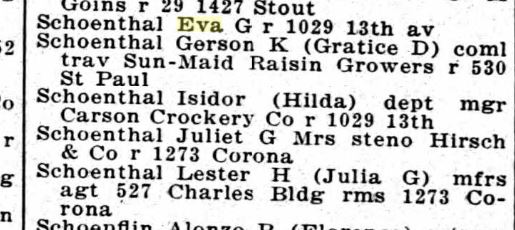
1922 Denver directory Ancestry.com. U.S. City Directories, 1822-1995 [database on-line]. Provo, UT, USA: Ancestry.com Operations, Inc., 2011.
1922 was an important year for my grandmother. She graduated from East Denver High School that year where she had been part of the Progressive Club (a music group, not a political group, as I had initially thought), a Big Sister, and a member of the Drama Club. I guess her roles in the Hanukkah plays were just a small part of her teenage acting career.
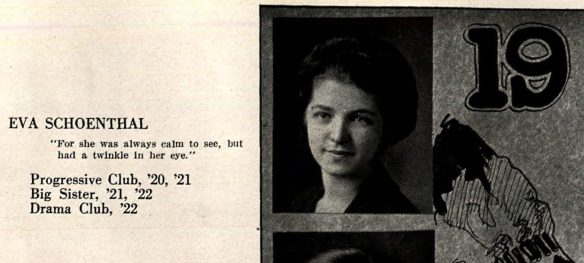
Eva Schoenthal high school yearbook picture Ancestry.com. U.S., School Yearbooks, 1880-2012 [database on-line]. Provo, UT, USA: Ancestry.com Operations, Inc., 2010. Original data: Various school yearbooks from across the United States.
It was after graduating from high school in 1922 that my grandmother went on a trip to Philadelphia to visit her relatives there and met my grandfather, John Nusbaum Cohen, who followed her back to Colorado to court her. They were married in Denver on January 7, 1923. Eva was only 18 years old, and my grandfather was 27. She moved back east with him to Philadelphia where their first child, my aunt Eva Hilda (for her two grandmothers, not really as a “junior”), was born on January 13, 1924. My father was born almost three years later. My grandmother, although the youngest, was the first of her siblings to have children, and her children were the only grandchildren her parents ever knew. (Harold would eventually have a child, but she was not born until long after both of my great-grandparents had died.)
As the 1920s moved on to the 1930s, much was going to change for my grandmother and her family. I will pick up with that part of the story after I return from a short break away from blogging.
In the meantime, happy New Year to you all. May 2016 bring everyone peace and good health and happiness. And may the world find some way to preserve our planet, to create a world where our children and grandchildren can be safe at home and at school and elsewhere, and to protect all its people from terrorism and despots and demagogues and from prejudice and hatred and fear. We all wish for that, don’t we? There must be a way we can get there without all the rancor and stupidity and fear-mongering that seems to dominate our air waves and our political process. At least I hope we can.

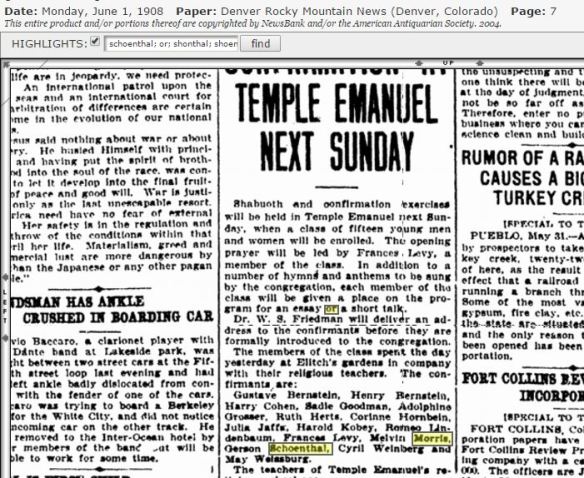
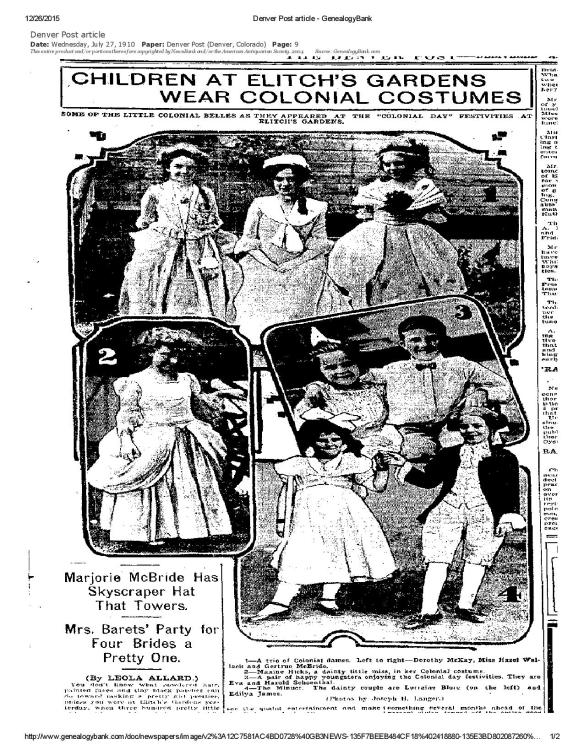




![1916 Denver directory Ancestry.com. U.S. City Directories, 1822-1995 [database on-line]. Provo, UT, USA: Ancestry.com Operations, Inc., 2011.](https://brotmanblog.com/wp-content/uploads/2015/12/schoenthals-1916-directory-p-2.jpg?w=584)
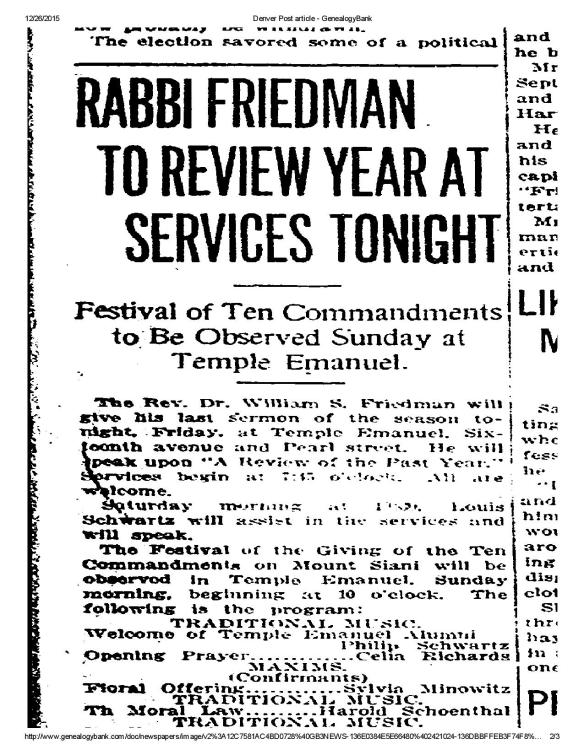



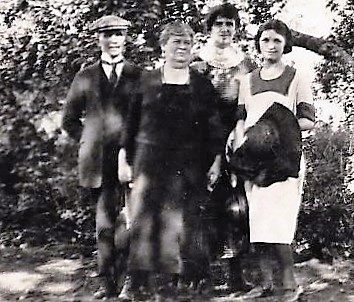
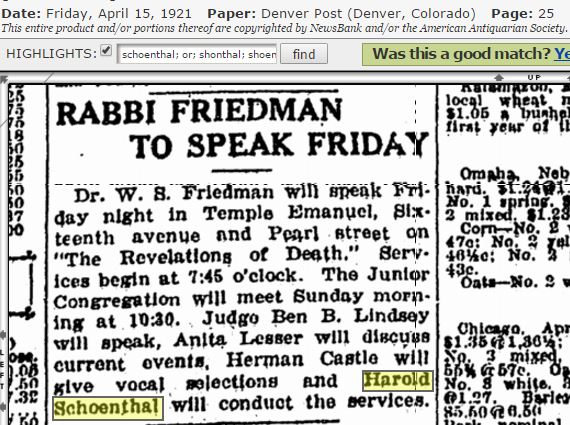

My very best wishes to you too Amy, for a happy, safe and successful year ahead. I’m looking forward to your new researches and learning more about your family. Happy New Year! Su.
LikeLiked by 2 people
Thanks, Su, and same to you! I am enjoying your photos, and I hope you have a chance to get back to genealogy also in 2016!
LikeLiked by 1 person
Thanks Amy. I hope so too. My son bought me a bunch of Scotland’s People credits for Christmas, so I have no excuse (except that the sun is shining, the beach is beckoning, and I really need to get my house ready to put on the market 🙂 )
LikeLike
Well, those all sound like very good excuses!! 🙂
LikeLiked by 1 person
Amy, I am continually amazed at all the local newspaper clippings you find about your family and I love reading about your family’s stories. Happy New Year!
LikeLiked by 2 people
It’s so much fun finding them—one of my favorite parts of the research. It’s time-consuming, and often I find nothing, but I’ve also had some really good luck. I’d never seen childhood pictures of my grandmother before!
LikeLike
Enjoy your time off. Happy New Year!
LikeLiked by 1 person
Thank you— to you also!
LikeLiked by 1 person
Amy, what a treasure trove of goodies in this post! Your blog is like a compendium of Jewish-American history!!! LOVED the children’s religious school activities!!!
LikeLiked by 2 people
Me, too! I knew nothing about their Jewish upbringing so this was a real revelation to me. I do love the newspaper searches!
LikeLike
There are some lovely pictures in this post, Amy! You’ve done such thorough research and you bring the stories of your ancestors to life so vividly they become almost like personal memories. Of course I wish you all the joys and all the best for your New Year – however late I am in wishing them!
LikeLiked by 1 person
It’s never too late for a New Year’s wish—same to you! And thank you for the kind words. Coming from someone with your writing skills, it means a lot.
LikeLiked by 1 person
Two of my favorite things is old photographs and newspaper clippings. This is such an interesting post and you must be continually thrilled to have the window into the lives of your family that your excellent research provides. THank you.
LikeLiked by 1 person
I do love finding those news articles, and I wish I had MORE old photos! It’s so exciting to get those insights into their lives. Thanks for reading and for your kind words!!
LikeLiked by 1 person
Pingback: Passover 2016: The Exodus | Brotmanblog: A Family Journey
Pingback: Denver and A New Portrait of My Grandmother | Brotmanblog: A Family Journey
Pingback: My Great-Grandmother Hilda | Brotmanblog: A Family Journey